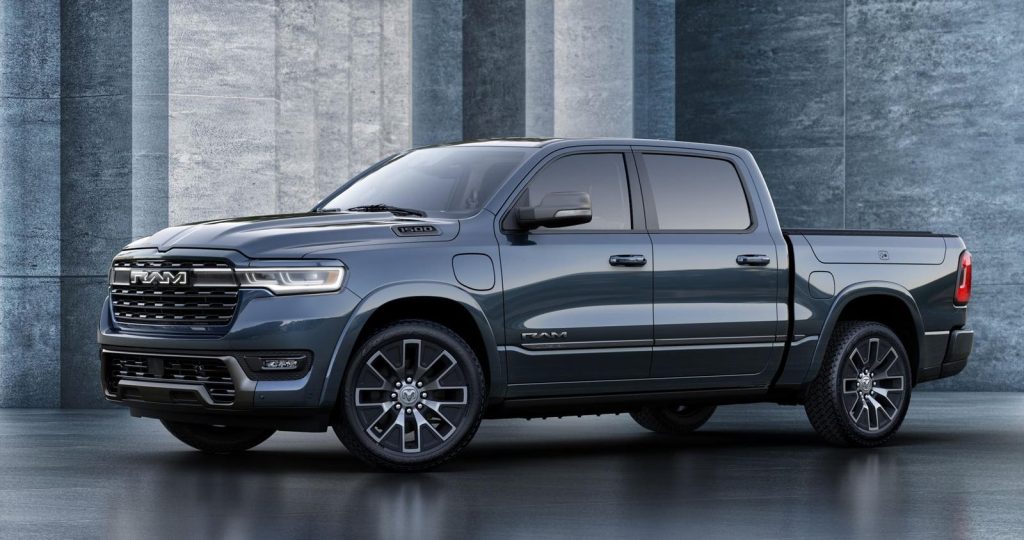Among the current crop of full-size pickup trucks, the Nissan Titan and Ram 1500 are the oldest designs having launched in 2016 and 2018 respectively. Nissan is addressing that problem by discontinuing the Titan in 2024. But Stellantis is sticking around and giving its big trucks a significant update that includes dropping all V8 engines and adding a new Ramcharger variant with a V6 and a battery that they really don’t want anyone to call a plug-in hybrid.
A Mild Facelift
Spy photos of the 2025 Ram trucks have been floating around online for months and the fact that only the front and rear of the truck have been extensively covered gives a strong hint about the extent of the redesign, which is to say not very extensive. Most of the sheet metal is carried over and frankly that’s not a problem. Despite being familiar, the Ram 1500 is arguably still the best looking full-size truck on the market.
The headlamp clusters have gotten slimmer and on Limited trims and above, they now feature standard twin bifunctional LED projectors. In between is a slightly wider grille that now has a bit of a forward lean to it, just in case modern trucks don’t look imposing enough.
New for 2025 is an even more premium luxury truck above the Limited called Tungsten. The Tungsten trim was first previewed earlier this year on the Ram 1500 Rev electric pickup. On the internal combustion Tungsten, there are other changes to the front fascia including the elimination of the traditional steel bumper found on trucks in favor of a bumper cover that is more integrated into the design. This gives a cleaner, more upscale look to a truck that isn’t intended to go any further off-road than the dirt path to your lakeside cabin.
On the inside, the Ram remains relatively familiar which again is a good thing. Even after multiple years on the market, the Ram 1500 still has the best looking and feeling cabin among large trucks. The materials and colors get a further upgrade for the new year and the touchscreens are also improved.
The 12-inch portrait style infotainment screen has a new higher resolution display on lower end trims. The top trims now get an even larger 14.5-inch screen and front passengers can also have their own 10.25-inch display just like the Jeep Wagoneer and Grand Cherokee with a filter that prevents the driver from viewing the screen. There are now 6 USB ports in the front (3 each of type-A and type-C) plus 4 for the back seat. The larger screen is flanked by dedicated climate control buttons so you don’t have to search through menus for a quick temperature adjustment.
New Tech Features
The 2025 Ram 1500 is the first Stellantis product to offer hands-free driver assistance capability similar to Ford BlueCruise and GM Super Cruise. The hands-on Active Driving Assist helps keep the truck centered in the lane on all roads. When running on approved mapped roads the driver can go hands off but must continue watching the road with an infrared camera watching the driver’s eyes and hand position to make sure they are attentive. Ram is also debuting a new premium audio setup for 2025 powered by Klipsch.
Ram has also added a trailer hitch assist system similar to the one offered by Ford on the F-series trucks. Using the rear backup camera and other sensors, it can automatically back up the truck and align the hitch ball with the trailer for easy connection. Like Ford’s current trucks, the gas Rams will offer electrical outlets in the bed with an inverter that can output up to 2-kW for tools or other gear.
The End of the Hemi
It should come as a surprise to no one that the 2025 Ram 1500 no longer offers any V8 engines. As the best selling Stellantis vehicle in North America, the Ram trucks have a significant influence on the automaker’s corporate average fuel economy and while the Hemi V8s were strong, they were thirsty. With the worst CAFE numbers in the industry, Stellantis needed to improve. The veteran reliable and cheap 3.6-liter Pentastar V6 with the eTorque mild hybrid system remains the standard engine in the new Ram.
But for those that need more capability, the 3.0-liter twin-turbocharged Hurricane inline six that debuted last year in the Wagoneer is now the upgrade option with two different power levels. The standard output variant produces 420-hp and 469 lb-ft of torque easily outdoing the 5.7-liter Hemi. The high-output version produces 540-hp and 521 lb-ft, even more than in the Wagoneer.
This aluminum block and head engine is designed to be extremely robust with cross-bolted steel main bearing caps and plasma coated cylinders that are tougher than steel liners. Ram officials won’t say what the Hurricane is actually capable of producing, but there have been hints that with more boost, it may be able to rival the soon to be discontinued Hellcat supercharged V8.
With that 700-hp blown Hellcat going out of production at the end of 2023, the TRX badge is also being put on the shelf for the time being. Ram chief Tim Kuniskis won’t say if it will come back, but the “on-the-shelf” comment hints that we might someday see it again. Until that happens, the high-speed desert running capability of the TRX is being largely carried over in the new RHO model powered by the high-output Hurricane engine. With 540-hp, it does still outpace the 450-hp 3.5-liter EcoBoost in the standard F-150 Raptor.
Don’t Call It a Hybrid
Back in June 2021, when Stellantis laid out its master plan for going electric, several vehicles were hinted at, but no details were provided. Those have been slowly trickling out in the more than two years since. One of those hints was a reference to a range extender electric pickup. In April of this year, we saw the Ram 1500 Rev with a claimed range of up to 500 miles thanks to a massive 229 kWh. The range extender has been hinted at several times, but only now do we have actual details in the form of the Ram 1500 Ramcharger with at least two instances of name redundancy.
Despite insisting on not calling the Ramcharger a hybrid, it is in fact a plug-in series hybrid. There are two main forms of hybrid powertrain, the parallel hybrid where both an engine and electric drive system can power the wheels as with most hybrids on the road today. The other is a series hybrid where the engine is only used to drive a generator that produces electricity to charge the battery and electric motors drive the wheels.
The original Chevrolet Volt concept of 2007 was a series hybrid but by the time the car made it to production, reuse of off-the-shelf components to save cost turned it into more of a parallel in some driving cases. The Fisker Karma was a plug-in series hybrid and Nissan’s current e-Power systems in Japan are too, although they have a smaller battery and no plug, so the engine charges the battery continuously.
The Ramcharger is another kind of beast. Like the Rev, it’s built on the STLA Frame EV platform. The gas engined trucks and utility vehicles from Stellantis have frame rails that run essentially straight from front to rear. The STLA Frame version has rails that spread outward between the axles, allowing room for a larger battery like that used by GM. The Ford Lightning uses a modified version of the ICE frame with straight rails, constraining the size of the battery to just 130 kWh compared to the 168-kWh standard battery in the Rev.
The Ramcharger gets a 92-kWh battery not much smaller than the standard 98-kWh unit in the Lightning. In the Ramcharger, this battery is projected to deliver about 145 miles of electric range. Propulsion comes from the same front and electric drive units as the Rev, putting out 663-hp and 615 lb of torque. That’s enough for a projected 0-60 mph time of 4.4 seconds.
Sitting above the front drive unit is a modified Pentastar V6 with an electric generator bolted to the back of the block. The generator can produce up to 130-kW continuously and up to 190-kW to meet transient demand.
By default, the Ramcharger runs on juice from the battery and as it approaches about 20% state of charge, the V6 generator combination comes on to maintain or build the level of the charge in the main battery. Between the battery and rear axle there is a 27-gallon gas tank. The combination is expected to deliver a range of about 690 miles.
Like the plug-in hybrid 4XE system on Jeeps, the Ramhcharger offers multiple modes including Eco, e-Save and Electric+. The e-Save mode forces the generator to run, preserving the battery charge for a later time or building up the charge for an anticipated extra load such as climbing a long grade while towing a heavy trailer.
Like the Rev, the Ramcharger will be able to tow 14,000-lbs and will have a payload capacity of 2,625-lbs. That’s about double the payload capacity of the Silverado EV and 400-lbs more than the lightest version of the Lightning. While the maximum range while towing depends on multiple variables such as the size and aerodynamic characteristics of the trailer as well as terrain, Ram engineers estimate that it should be able to tow a large trailer at least 300 miles over relatively flat terrain when starting with a full charge.
The presence of the V6-generator combination means that unlike the Rev, the Ramcharger won’t be able to offer a frunk. But for those that need to tow over long distances while also having a truck that handles virtually all daily driving without using any gas, the Ramcharger is a unique combination with far more capability and electric range than any other plug-in hybrid in the world.
The Ramcharger is expected to launch at the same time as the Rev in late 2024 but like the battery electric truck, Ram isn’t talking pricing yet. However, Kuniskis did highlight the cost of the 76-kWh difference in battery size between the Ramcharger and standard range Rev. Assuming a conservative estimate of $120/kWh for the battery, the smaller battery of the Ramcharger could save over $9,000 in battery cost. Adding in $4,000 to $5,000 for the generator and associated hardware, the Ramcharger could end up being at least several thousand dollars cheaper to build if not necessarily to buy and it will probably roughly the same weight as the standard range Rev with a full tank of fuel.
A trio of electric full-size truck variants could be just the combination that Stellantis needs to make a real dent in the market despite being somewhat late to enter. Between 2 battery only versions with 350 to 500 miles of a range and a version with an on-board generator to keep the battery at a useful state of charge, this could be just what Stellantis needs to make its CAFE compliance goals. Kuniskis declined to say how many Revs and Ramchargers they expect to sell, but did say that they need at least 20% of their trucks electrified to hit Stellantis’ compliance requirements while the company has a broader target of 50% BEV market share by 2030. So Ram will probably be targeting about 80,000 to 100,000 sales of its battery propelled trucks in the early years.
The new Hurricane-powered gas Ram 1500s will go on sale in early 2024 with the Rev and Ramcharger in the fourth quarter.
Read the full article here










